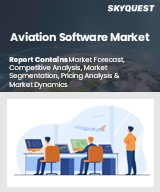
세계의 항공 소프트웨어 시장 규모는 2023년에 96억 달러로 평가되었으며, 2024년 102억 6,000만 달러에서 2032년에는 175억 달러로 성장하고, 예측 기간(2025-2032년) 동안 CAGR 6.9%로 증가할 전망입니다.
세계 항공 소프트웨어 시장은 항공 업계의 업무 효율성 향상, 안전 기준 강화, 디지털 혁신의 필요성에 힘입어 빠르게 성장하고 있습니다. 항공사와 공항은 비용 절감, 비행 관리 최적화, 승객 경험 향상에 점점 더 집중하고 있으며, 정교한 소프트웨어 솔루션의 도입이 매우 중요해지고 있습니다. 이러한 시장 확대는 항공 여행 증가, 항공기 보유 대수 증가, 유지보수, 수리, 비행 계획 수립을 위한 실시간 데이터 분석에 대한 수요에 영향을 받고 있습니다. 또한, 클라우드 기반 솔루션으로의 전환은 확장성, 유연성, 비용 효율성을 촉진하고 있습니다. 에어버스 SE, 보잉, 하니웰 인터내셔널, SAP SE를 비롯한 업계 선도 기업들은 다양한 업무에 필요한 통합 소프트웨어 제품군을 제공함으로써 시장 점유율을 놓고 경쟁하고 있습니다.
Global Aviation Software Market size was valued at USD 9.6 billion in 2023 and is poised to grow from USD 10.26 billion in 2024 to USD 17.5 billion by 2032, growing at a CAGR of 6.9% during the forecast period (2025-2032).
The global aviation software market is experiencing rapid growth, propelled by the need for enhanced operational efficiency, heightened safety standards, and digital transformation within the aviation industry. Airlines and airports are increasingly focused on reducing costs, optimizing flight management, and elevating the passenger experience, making the adoption of sophisticated software solutions crucial. This market expansion is influenced by the rise in air travel, growing aircraft fleets, and the demand for real-time data analytics for maintenance, repair, and flight planning. Additionally, the shift towards cloud-based solutions is driving scalability, flexibility, and cost efficiency. Major industry players, including Airbus SE, Boeing, Honeywell International Inc., and SAP SE, are vying for market share by offering integrated software suites that address a range of operational needs.
Top-down and bottom-up approaches were used to estimate and validate the size of the Global Aviation Software market and to estimate the size of various other dependent submarkets. The research methodology used to estimate the market size includes the following details: The key players in the market were identified through secondary research, and their market shares in the respective regions were determined through primary and secondary research. This entire procedure includes the study of the annual and financial reports of the top market players and extensive interviews for key insights from industry leaders such as CEOs, VPs, directors, and marketing executives. All percentage shares split, and breakdowns were determined using secondary sources and verified through Primary sources. All possible parameters that affect the markets covered in this research study have been accounted for, viewed in extensive detail, verified through primary research, and analyzed to get the final quantitative and qualitative data.
Global Aviation Software Market Segments Analysis
Global Aviation Software Market is segmented by Technology, Operation, Application, Software and region. Based on Technology, the market is segmented into Security System, Communication System, Passenger, Cargo & Baggage Handling, ATC and Others. Based on Operation, the market is segmented into Aeronautical and Non-aeronautical. Based on Application, the market is segmented into Airports and Airlines. Based on Software, the market is segmented into Design Software, Simulation Software and MRO Software. Based on region, the market is segmented into North America, Europe, Asia Pacific, Latin America and Middle East & Africa.
Driver of the Global Aviation Software Market
The Global Aviation Software market is experiencing significant growth driven by the increasing demand for automation in various operational tasks. This sector facilitates critical functions such as flight planning, crew scheduling, and maintenance management, streamlining processes for greater efficiency. Additionally, the need for real-time data and advanced analytics is becoming essential for optimizing fuel consumption, enhancing air traffic management, and implementing predictive maintenance strategies. As stakeholders in the aviation industry recognize the benefits of leveraging software solutions to enhance operational efficiency and improve safety, the market continues to evolve and expand in response to these pressing requirements.
Restraints in the Global Aviation Software Market
The Global Aviation Software market faces notable challenges due to high costs linked to implementation, customization, and maintenance of intricate systems. Smaller and mid-tier airlines and airports often struggle to manage the initial investments required for enterprise-level software solutions. Additionally, the operational complexity of these software systems can act as a significant deterrent. Continuous expenses for updates, specialized training, and ongoing support can quickly accumulate, leading many operators to confront financial burdens that overshadow the intended benefits of using such software. This reality poses a considerable obstacle for stakeholders attempting to leverage technology to enhance operational efficiency.
Market Trends of the Global Aviation Software Market
The Global Aviation Software market is experiencing a significant transformation driven by the integration of AI and machine learning for predictive maintenance solutions. These advancements enable airlines and operators to harness vast amounts of real-time data collected from aircraft sensors, facilitating accurate predictions of potential equipment failures and timely maintenance requirements. As a result, aviation stakeholders can proactively address maintenance issues, reducing unexpected downtime and optimizing operational efficiency. This trend not only minimizes maintenance costs but also enhances overall safety and reliability in aviation operations, signifying a robust shift toward data-driven decision-making in the industry.